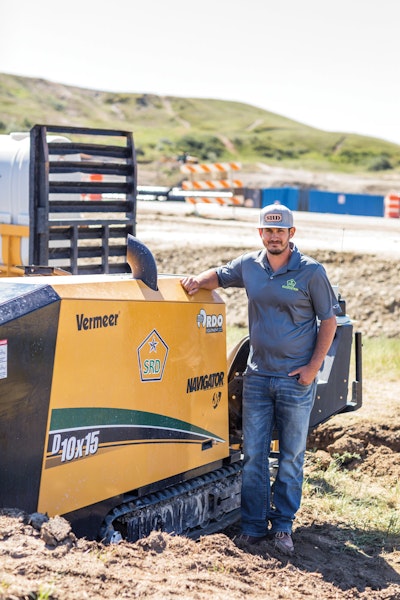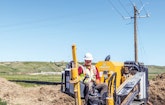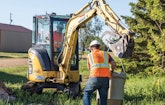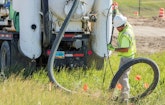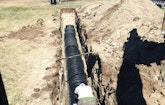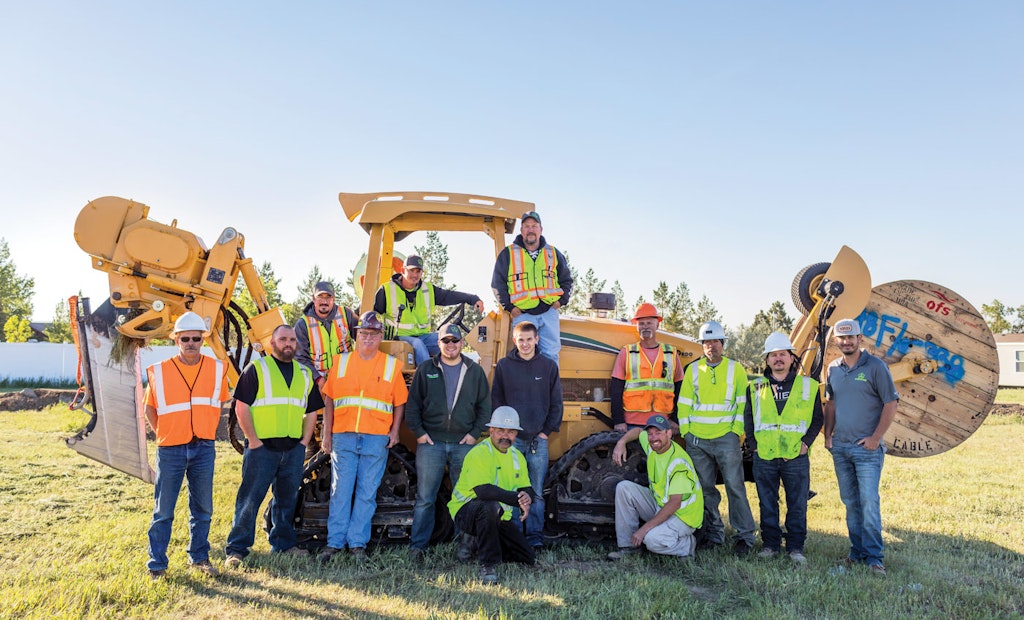
The SRD Construction/Excavation team includes (from left) Rob Marshall, Travis Lindenberg, Nyles Brown, Stacy Allee, Vance Torgerson, Josh Stock, Ray Montanez, Shane Potter, Sanford Jones, Thad Salter, Tyler Myskewitz, David Ravis, Junior Balle and Seth Dixon. (Photos by Gabriel Black)
As a youngster in the 1990s, Seth Dixon used to help his stepfather install septic systems in and around Olympia, Washington. Now, the owner of SRD Construction/Excavation in Williston, North Dakota, still installs septic systems — and a whole lot more.
By adding diversified services such as waterline and sewer line installations, horizontal directional drilling, trenching and cable plowing, hydroexcavating, road building, and site preparation, Dixon has dramatically increased the size of his company. How much? For perspective, consider that in 2013 — the year Dixon established SRD (which use his initials, Seth Ryan Dixon) — he had $3,000 in a bank account and owned just a dump truck and a trailer.
Since then, the 31-year-old entrepreneur has invested more than $1.5 million in productivity-enhancing equipment. And along the way, he expanded geographically into neighboring Montana and established footholds in new markets, particularly laying fiber optic cable for a Montana-based communications company.
But installing septic systems still is a staple service for SRD, which puts in 30 to 50 systems a year. “It’s always been a very steady business,” Dixon explains. “It’s never really grown or shrunk, which is the main reason why I never stopped doing it. Someone always seems to need a septic system installed.”
“I could do more installations … but I don’t chase the work,” he adds. “We don’t have the time or the employees to do more. But it’s always good to have that steady work to fall back on.”
Almost all of the installations are gravelless systems for new homes, typically built on lots of at least 1 acre. And Dixon says SRD’s ability to do more than just install septic systems helps him win installation business from construction contractors. “We can offer homebuilders a full package,” he points out. “We can do the dig-out for the foundation, backfill the foundation, and install the waterline and the septic system,” he says. “After that, we also can do the final grade. So in the end, they only have to use one contractor.”
COMPLEX TO SIMPLE
When Dixon worked for the installation company that his stepfather, Ben Potter, owned in Washington state, sophisticated and complex systems were the norm. As an example, he cites the M31 system developed and manufactured by Glendon Biofilter Technologies. It’s primarily designed for lots with poor-draining soil and/or high water tables.
Waste still flows into a collection tank, but any similarities to conventional systems end there. From the tank, effluent gets pumped into roughly 8-foot-long, 6-foot-wide concrete “pods” with no lids. The number of pods required equals the number of bedrooms in a home, he says.
“Each pod has a liner,” Dixon explains. “You fill the pods with gravel and sand that acts like a filter. Then, cover it all up with a layer of sand, a jute mat and a little topsoil.” Capillary action wicks the effluent through the sand-and-gravel medium, over the rim of the pod and into the surrounding soil. Such systems could cost anywhere from $30,000 to $50,000 and could take up to 40 hours to install, he explains.
Things are much simpler in North Dakota, where Dixon says he primarily installs concrete tanks dosing effluent into Quick4 chambers from Infiltrator Water Technologies. The average tank size ranges from 1,000 to 1,500 gallons.
North Dakota counties aren’t regimented when it comes to requirements for installing septic systems. Dixon says the counties where he works send installers a design sheet that outlines general site parameters, such as soil type and the square footage required for a drainfield, then gives installers discretion to choose which system would work best. Options typically include a conventional gravity system with gravel and lateral pipes, a mound, or a gravelless system.
“I’ve never had a really challenging installation here,” Dixon says. “We mostly put in plain old residential gravity systems, with an occasional commercial job.”
A PASSION FOR MACHINES
Dixon has been involved in excavation and heavy equipment for most of his life. His father, Jack, worked as a heavy-equipment operator. “Between him and my stepdad, I literally grew up on heavy equipment,” Dixon says.
Dixon started doing excavating for mainline sewers at age 18. Then he got a job doing excavations for natural gas pipelines, which took him all over the country. But around 2010, he grew tired of the travel and extremely long hours. So he took a job as a foreman for a Montana contractor that performed waterline and sewer line installations.
During that time, he met his wife, Jessica, who was raised in Williston. Within a year, the couple moved to Williston, where Dixon abruptly decided to start his own company in November 2013. “I just got tired of working for other people,” he explains.
To get started, Dixon leased a skid-steer and a mini-excavator and started installing septic systems. At the same time, he studied for and passed the state test to become a licensed water and sewer contractor. He also borrowed $13,000 from his in-laws and bought a dump truck and trailer. He paid off the loan in six months by installing septic systems and doing site preparation work.
Dixon kept prospecting for new clients. Later in 2014, he caught a break: After getting edged out by a more experienced contractor on a bid to dig footings for an expansion at a big-box retailer and stabilize its deteriorating parking lot, Dixon got called in to finish the work. That gave him his first taste of the challenges posed by rapid growth.
“That ramped us up from two employees to six or seven,” he says. “Also, it happened in late fall, so we had to hurry up to finish before the ground froze. As an owner, going from two to seven employees is a big leap both in time commitment and asset management.
“We had to rent a lot more iron, too, so we went from barely any bills to a lot of bills in a hurry,” he continues. “Logistically, there were a lot more moving pieces to keep track of. Plus, I also wanted to be sure the job was profitable and done right. I’m big on quality work.”
PERSISTENCE PAYS
As Dixon talks about his business, two things emerge as factors in his company’s rapid growth: quality control and persistence. Doing quality work led to repeat business and word-of-mouth referrals. And persistence — in terms of continually but diplomatically reminding prospective customers that he was interested in doing more work — more often than not got his foot in the door.
“I’m big on quality all the way around,” he says. “And that’s exactly why we are where we are today. We make sure the product we’re turning over to a client is exactly what they wanted — no cutting corners.”
The value of persistence was demonstrated in 2015, when SRD landed a contractor to perform fiber-optic-line installations for a large communications company based in Montana. After installing a fire line (a 6-inch-diameter line that supplies water for fire-sprinkler systems) for the company in a building it owned in Williston, Dixon kept asking the company for more work.
Satisfied with the fire line project, the communications company kept giving SRD small jobs — think of them as test runs. The business relationship grew, and now SRD is the company’s sole contractor for moving and reinstalling fiber optic lines during road projects as well as new fiber-optic-line installations, he says.
TOOLS OF THE TRADE
Providing an array of services allows Dixon to hedge against cyclical slowdowns in various business sectors. “I hate to say no if we get a call to do something,” he explains. “So we keep adapting (to customers’ needs) by adding services.
“Keeping our services diverse is a big growing point,” he continues. “It puts us out there. … If people need waterlines fixed or septic systems installed, I want them to think SRD.”
Providing so many services requires a diverse inventory of equipment. Dixon relies on a 2012 Case CX210 excavator, a Case CX36B excavator, a Case 1850K bulldozer and a Caterpillar 277B skid-steer.
The company also owns a Vermeer P-1250 cable plow with a reel carrier and a trencher attachment for winter work, a Case 580 Super N wide-track backhoe, two mini-excavators made by Komatsu America and Case Construction Equipment, a cable plow manufactured by Ditch Witch, a Vermeer 10x15 directional drill, and a Case 6030 directional drill.
SRD also relies on a 1997 Ford F-800 bucket truck, a pull tractor made by Massey Ferguson (a brand owned by AGCO), a 1999 International dump truck, a Ditch Witch 350 small-service cable plow/trencher, a 1989 Caterpillar 613 scraper, a 1999 Sterling tractor cab, a 2006 35-foot end-dump trailer made by HILB, and two paving rollers built by BOMAG Americas (a Fayat Group company).
In addition, SRD owns a hydroexcavation truck built by VACMASTERS on a 1999 GMC 5500 chassis with a 500-gallon debris tank, a 350-gallon water tank, a water pump built by General Pump (owned by Interpump Group), and a 3,000 cfm blower manufactured by Roots Systems. A variety of trailers round out the fleet; they’re made by Lambert Tractor & Machinery Sales, Pace American, Trail King Industries, Econoline Trailers, Redi-Haul Trailers and PJ Trailers.
Buying and renting equipment has been one of the biggest challenges for Dixon. He had no credit rating when he started out, which made it impossible to obtain financing to buy equipment. The situation worsened a bit when he incorporated the company in early 2015 to separate his personal finances from the company’s (he had been operating as a sole proprietor).
“As a result, on paper the company is only a year and a half old, so it’s still hard to get credit,” he notes. “Incorporating kind of kicked us in the shins financially.” But thanks to good relationships with leasing companies and quick payments by his largest customer — keeping cash flow up — Dixon is managing to obtain the equipment required to meet the increasing demand from customers.
Looking ahead, Dixon expects further growth, particularly in the market for laying fiber optic cables. But, he also figures the company will always install septic systems, too, along with other core services like road work and installing waterlines and sewer lines. “I can’t get rid of those core services,” he says. “That’s where my roots are.”
Focus on the big picture
Many contractors believe getting things done right means doing it themselves. Seth Dixon used to operate that way until he acquired two unwanted partners in his business: stress and burnout.
Rapid growth at SRD Construction/Excavation pushed Dixon to a point where he realized he couldn’t do everything. So, he hired a secretary to handle invoicing and other administrative details as well as a company to process payroll. “Now I basically handle crisis management — make sure things are going right,” he says.
Dixon also delegated more responsibility to his right-hand man, Sanford Jones, the company’s head superintendent. “He’s the key person in our operation,” Dixon explains. “He’s always the first one there and the last one to leave. He’s also great with quality control and keeping projects going on schedule. In addition, he’s very reliable. If I ask him to do something, it’s done; I never have to wonder about it.”
Of course, delegating responsibilities to others requires employees who can handle the extra work. And like so many contractors nationwide, Dixon struggles to find employees with the right experience, values and work ethic. “Finding someone with a construction background who’s also knowledgeable and wants to work and doesn’t carry a lot of baggage, like drunken-driving convictions, is a nightmare,” he says. “Recruiting people is a real struggle.”
To identify job candidates, Dixon says he’s has been trying outlets such as Facebook, Craigslist and temporary-employee agencies. “There’s a Facebook page called People of HDD Help Wanted,” he says. “It’s like a Facebook page for horizontal directional drilling employees around the country who are looking for work.”
Dixon also is considering implementing production bonuses as an incentive to recruit new employees. In the meantime, a main strategy for finding quality employees is a volume approach. “I find quality employees through sheer volume of hiring,” he says. “I’m not sure how else to explain it — that’s just how it is.”
